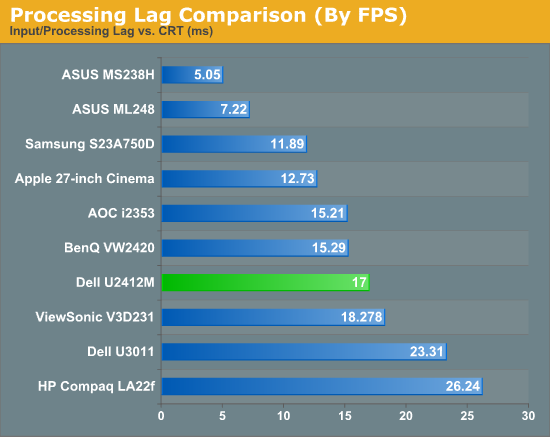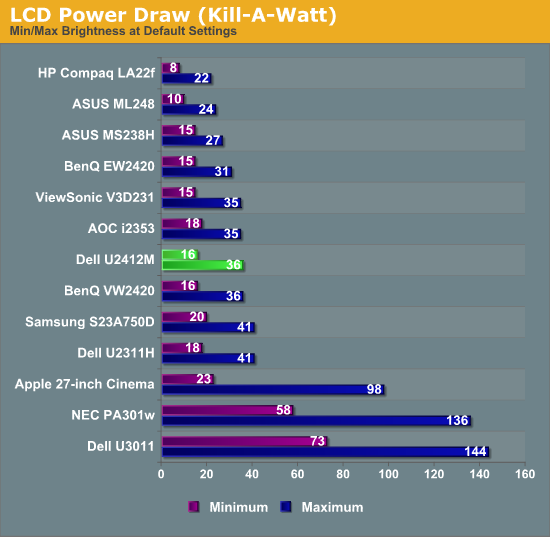Dell U2412M - 16:10 IPS without Breaking the Bank
by Chris Heinonen on February 28, 2012 9:00 AM ESTDell U2412M Input Lag and Power Use
For testing lag, I am trying a new solution to our previous testing method. I’m trying out SMTT, which is designed specifically for measuring lag in LCD displays. Using DirectX it manages to push over 1,000 frames per second to a display, allowing for millisecond accuracy instead of relying on time demos that often run well below that threshold. Using this method, we can actually determine two different values: The input lag for the LCD to initially respond, and then the total lag from when the new frame is received to when it is completely drawn and at full brightness. This last one is the overall important value, as it is what gamers would be most concerned with. It’s important to have as low an "input lag" as possible so that even if the screen isn’t fully drawn yet (the pixels will be changing over) you will be able to begin to get that feeling of responsiveness.

Here we see that the overall lag value measured OK, at 17ms. The input lag, which was also measured, was just under 2ms, which indicates that the Dell responds very quickly, and then it’s just a matter of the pixel response time. One thing to keep in mind here is that the 17ms response time is the total time from input to peak brightness, and then it takes 15ms to fall back to another value. When I actually look at the test subjectively and not objectively, you can certainly see the change in the pixel after 7-8ms of time. So I could report it as 8ms of lag, as that’s about what I think you would experience in a real world situation, but the worst case scenario seems to be 17ms, which is what I’m choosing to report as that’s the objective number.
The CRT still comes in perfect, and that’s what the LCD should aim to do; picking a number that gives a better result, even if it might be more applicable to the real world, feels like cheating. Perhaps we will get a future display technology (like OLED or CrystalLED that I saw at CES this year) that will bring us back to CRT response times, but until that happens I’m going with the objective, worst case measurement. I will report the “real world estimate” along with it, though, so you can use that for your own judgment. Please let me know what you think of this in the comments section.
I made the assumption that with a larger panel and the 300 nits of light output that the Dell would not be the most eco friendly panel I had seen. Happily I found this to not be the case. It drew just 36 watts at maximum brightness and only 16W at minimum brightness, less than even the 23” Dell U2311H from last year. I don’t know if it is more efficient LED lights, or a more transparent panel that allows more light through, but Dell did a good job keeping the power use low on the U2412M.











143 Comments
View All Comments
Braumin - Tuesday, February 28, 2012 - link
I bought this when it first came out. I had been looking at an IPS monitor to replace my aging S-PVA monitor. I really hate TN.The price is just amazing on this, and the quality is top notch.
No, it doesn't have everything that everyone needs, but it has exactly what I needed.
Great review!
Oxford Guy - Tuesday, February 28, 2012 - link
What's wrong with the monitor you have? Is the backlight becoming too weak or what?Braumin - Wednesday, February 29, 2012 - link
19" 1280x1024 was good when I got it, but really not enough desktop space. I much prefer the widescreen for gaming and such.TegiriNenashi - Tuesday, February 28, 2012 - link
The statement that 16:9 panels were introduced at lower prices is false. I clearly remeber that the "latest and greatest" "Full HD" were rarity and commanded a premium, compared to "boring" 1920x1200 panels, which could be found anywhere from $200 and up.JarredWalton - Tuesday, February 28, 2012 - link
I'm sorry, but I'll have to disagree. I don't know that I've ever seen a new 24" 1920x1200 display for under $250, period. Not even the cheap, TN, low quality displays with now height adjustment have gotten that low. But 1080p, while perhaps there were a few more expensive models initially, rapidly dropped into the <$250 range for 23-24" models, and now they start at around $170 (compared to $270 for the cheapest 1920x1200 LCD).Zoomer - Tuesday, February 28, 2012 - link
Remember back in Sept when some idiot mentioned HP was divesting it's PC division? The ZR24w dropped to $250 after rebate then.And the vw266 was under $250 for some time. Not technically 24", but I figure being bigger shouldn't count against it.
kmmatney - Tuesday, February 28, 2012 - link
Those are rare exceptions, but for the most part 1920 x 1200 monitors were always pretty expensive, and it wasn't until the 1080p monitors came out that prices started to really drop. My Soyo 24" MVA panel was a bargain at $299 when it came out, and after these sold out there wasn't anything near that price for 2 years in terms of price and quality.papapapapapapapababy - Tuesday, February 28, 2012 - link
stoper reading at led backlight, ill stick with my u2711... led backligth makes me sick( literally)
Death666Angel - Tuesday, February 28, 2012 - link
Not sure why you would want to change to a 24" model from a 27" inch one, but I'll bite:The PWM for brightness makes you sick, not the LED technology itself. The HP ZR2740w has no PWM and regulates brightness continually. See for example: http://www.prad.de/new/monitore/test/2012/test-hp-...
Oxford Guy - Tuesday, February 28, 2012 - link
Every LCD monitor review should measure flicker.I really want to get a constant control backlight, but I like my A-MVA panel's high contrast ratio.
If review sites put pressure on manufacturers by highlighting this problem, then maybe we'll see less PWM flicker.